Evaluation of Water-Energy-Food-Ecology System Development in Beijing-Tianjin-Hebei Region from a Symbiotic Perspective and Analysis of Influencing Factors
Abstract
1. Introduction
2. Study Area and Research Methods
2.1. Study Area
2.2. Research Framework
2.3. Indicator System Establishment
2.4. Data Pre-Processing and Index Weighting
2.5. Coupling Coordination Degree (CCD) Model
2.6. Influence Factor Analysis Using Gray Correlation Model
3. Results
3.1. Comprehensive Development Level Analysis
3.2. Coupling Coordination Degree (CCD) Development
3.3. Analysis of the Main Influencing Factors
4. Discussion
5. Conclusions and Policy Implications
5.1. Main Conclusions
5.2. Policy Implications
Author Contributions
Funding
Institutional Review Board Statement
Informed Consent Statement
Data Availability Statement
Conflicts of Interest
References
- Fouladi, J.; AlNouss, A.; Al-Ansari, T. Sustainable energy-water-food nexus integration and optimisation in eco-industrial parks. Comput. Chem. Eng. 2021, 146, 107229. [Google Scholar] [CrossRef]
- Martinez-Hernandez, E.; Leach, M.; Yang, A. Understanding water-energy-food and ecosystem interactions using the nexus simulation tool NexSym. Appl. Energy 2017, 206, 1009–1021. [Google Scholar] [CrossRef]
- Helmstedt, K.J.; Stokes-Draut, J.R.; Larsen, A.E.; Potts, M.D. Innovating at the food, water, and energy interface. J. Environ. Manag. 2018, 209, 17–22. [Google Scholar] [CrossRef]
- Dong, F.; Shi, L. Regional differences study of renewable energy performance: A case of wind power in China. J. Clean. Prod. 2019, 233, 490–500. [Google Scholar] [CrossRef]
- Lu, C.; Song, Z.; Wang, W.; Zhang, Y.; Si, H.; Liu, B.; Shu, L. Spatiotemporal variation and long-range correlation of groundwater depth in the Northeast China Plain and North China Plain from 2000∼2019. J. Hydrol. Reg. Stud. 2021, 37, 100888. [Google Scholar] [CrossRef]
- Zhang, F.; Wang, Y.; Ma, X.; Wang, Y.; Yang, G.; Zhu, L. Evaluation of resources and environmental carrying capacity of 36 large cities in China based on a support-pressure coupling mechanism. Sci. Total. Environ. 2019, 688, 838–854. [Google Scholar] [CrossRef] [PubMed]
- Huang, Y.; Wang, J.; Li, J.; Lu, M.; Guo, Y.; Wu, L.; Wang, Q. Ecological and environmental damage assessment of water resources protection mining in the mining area of Western China. Ecol. Indic. 2022, 139, 108938. [Google Scholar] [CrossRef]
- Yao, S.; Chen, C.; He, M.; Cui, Z.; Mo, K.; Pang, R.; Chen, Q. Land use as an important indicator for water quality prediction in a region under rapid urbanization. Ecol. Indic. 2023, 146, 109768. [Google Scholar] [CrossRef]
- Hoff, H. Understanding the Nexus; Stockholm Environment Institute: Stockholm, Sweden, 2011. [Google Scholar]
- Mercure, J.F.; Paim, M.A.; Bocquillon, P.; Lindner, S.; Salas, P.; Martinelli, P.; Berchin, I.I.; de Andrade Guerra, J.B.S.O.; Derani, C.; de Albuquerque Junior, C.L.; et al. System complexity and policy integration challenges: The Brazilian energy-water-food nexus. Renew. Sustain. Energy Rev. 2019, 105, 230–243. [Google Scholar] [CrossRef]
- Heard, B.R.; Miller, S.A.; Liang, S.; Xu, M. Emerging challenges and opportunities for the food-energy-water nexus in urban systems. Curr. Opin. Chem. Eng. 2017, 17, 48–53. [Google Scholar] [CrossRef]
- Sun, C.; Yan, X.; Zhao, L. Coupling efficiency measurement and spatial correlation characteristic of water-energy-food nexus in China. Resour. Conserv. Recycl. 2021, 164, 105151. [Google Scholar] [CrossRef]
- Naderi, M.M.; Mirchi, A.; Bavani, A.R.M.; Goharian, E.; Madani, K. System dynamics simulation of regional water supply and demand using a food-energy-water nexus approach: Application to Qazvin Plain, Iran. J. Environ. Manag. 2021, 280, 111843. [Google Scholar] [CrossRef]
- Zhang, T.; Tan, Q.; Zhang, S.; Zhang, T.; Zhang, W. A participatory methodology for characterizing and prescribing water-energy-food nexus based on improved casual loop diagrams. Resour. Conserv. Recycl. 2020, 164, 105124. [Google Scholar] [CrossRef]
- Wang, Y.; Song, J.; Zhang, X.; Sun, H.; Bai, H. Coupling coordination evaluation of water-energy-food and poverty in the Yellow River Basin, China. J. Hydrol. 2022, 614, 128461. [Google Scholar] [CrossRef]
- Zisopoulou, K.; Karalis, S.; Koulouri, M.-E.; Pouliasis, G.; Korres, E.; Karousis, A.; Triantafilopoulou, E.; Panagoulia, D. Recasting of the WEF Nexus as an actor with a new economic platform and management model. Energy Policy 2018, 119, 123–139. [Google Scholar] [CrossRef]
- Purwanto, A.; Sušnik, J.; Suryadi, F.; de Fraiture, C. Using group model building to develop a causal loop mapping of the water-energy-food security nexus in Karawang Regency, Indonesia. J. Clean. Prod. 2019, 240, 118170. [Google Scholar] [CrossRef]
- Gao, J.; Xu, X.; Cao, G.; Ermoliev, Y.M.; Ermolieva, T.Y.; Rovenskaya, E.A. Strategic decision-support modeling for robust management of the food-energy-water nexus under uncertainty. J. Clean. Prod. 2021, 292, 125995. [Google Scholar] [CrossRef]
- Li, W.; Jiang, S.; Zhao, Y.; Li, H.; Zhu, Y.; He, G.; Xu, Y.; Shang, Y. A copula-based security risk evaluation and probability calculation for water-energy-food nexus. Sci. Total Environ. 2023, 856, 159236. [Google Scholar] [CrossRef] [PubMed]
- Wang, M.; Zhu, Y.-F.; Gong, S.-W.; Ni, C.-Y. Spatiotemporal Differences and Spatial Convergence of the Water-Energy-Food-Ecology Nexus in Northwest China. Front. Energy Res. 2021, 9, 665140. [Google Scholar] [CrossRef]
- Tonghui, D.; Junfei, C. Evaluation and obstacle factors of coordination development of regional water-energy-food-ecology system under green development: A case study of Yangtze River Economic Belt, China. Stoch. Environ. Res. Risk Assess. 2022, 36, 2477–2493. [Google Scholar] [CrossRef]
- Han, D.; Yu, D.; Cao, Q. Assessment on the features of coupling interaction of the food-energy-water nexus in China. J. Clean. Prod. 2019, 249, 119379. [Google Scholar] [CrossRef]
- Cheng, Y.; Wang, J.; Shu, K. The coupling and coordination assessment of food-water-energy systems in China based on sustainable development goals. Sustain. Prod. Consum. 2023, 35, 338–348. [Google Scholar] [CrossRef]
- Shi, H.; Luo, G.; Zheng, H.; Chen, C.; Bai, J.; Liu, T.; Ochege, F.U.; De Maeyer, P. Coupling the water-energy-food-ecology nexus into a Bayesian network for water resources analysis and management in the Syr Darya River basin. J. Hydrol. 2019, 581, 124387. [Google Scholar] [CrossRef]
- AbdelHady, R.S.; Fahmy, H.S.; Pacini, N. Valuing of Wadi El-Rayan ecosystem through water-food-energy nexus approach. Ecohydrol. Hydrobiol. 2017, 17, 247–253. [Google Scholar] [CrossRef]
- Karabulut, A.; Egoh, B.N.; Lanzanova, D.; Grizzetti, B.; Bidoglio, G.; Pagliero, L.; Bouraoui, F.; Aloe, A.; Reynaud, A.; Maes, J.; et al. Mapping water provisioning services to support the ecosystem-water-food-energy nexus in the Danube river basin. Ecosyst. Serv. 2016, 17, 278–292. [Google Scholar] [CrossRef]
- Chang, N.B.; Hossain, U.; Valencia, A.; Qiu, J.; Kapucu, N. The role of food-energy-water nexus analyses in urban growth models for urban sustainability: A review of synergistic framework. Sustain. Cities Soc. 2020, 63, 102486. [Google Scholar] [CrossRef]
- Wang, X.; Dong, Z.; Sušnik, J. System dynamics modelling to simulate regional water-energy-food nexus combined with the society-economy-environment system in Hunan Province, China. Sci. Total. Environ. 2023, 863, 160993. [Google Scholar] [CrossRef]
- Del Borghi, A.; Tacchino, V.; Moreschi, L.; Matarazzo, A.; Gallo, M.; Vazquez, D.A. Environmental assessment of vegetable crops towards the water-energy-food nexus:A combination of precision agriculture and life cycle assessment. Ecol. Indic. 2022, 140, 109015. [Google Scholar] [CrossRef]
- Ibrahim, M.D.; Ferreira, D.C.; Daneshvar, S.; Marques, R.C. Transnational resource generativity: Efficiency analysis and target setting of water, energy, land, and food nexus for OECD countries. Sci. Total Environ. 2019, 697, 134017. [Google Scholar] [CrossRef]
- Xing, S.; Zhang, X.; Jiang, Z.; Gong, Q.; Wang, Y. Full lifecycle-based sustainability evaluation for remanufacturing ecosystem services: A novel perspective of technology-ecology synergy. J. Clean. Prod. 2022, 381, 135187. [Google Scholar] [CrossRef]
- Liu, C.; Sun, W.; Li, P. Characteristics of spatiotemporal variations in coupling coordination between integrated carbon emission and sequestration index: A case study of the Yangtze River Delta, China. Ecol. Indic. 2022, 135, 108520. [Google Scholar] [CrossRef]
- Zhang, J.; Dong, Z. Assessment of coupling coordination degree and water resources carrying capacity of Hebei Province (China) based on WRESP2D2P framework and GTWR approach. Sustain. Cities Soc. 2022, 82, 103862. [Google Scholar] [CrossRef]
- Cui, X.; Fang, C.; Liu, H.; Liu, X. Assessing sustainability of urbanization by a coordinated development index for an Urbanization-Resources-Environment complex system: A case study of Jing-Jin-Ji region, China. Ecol. Indic. 2019, 96, 383–391. [Google Scholar] [CrossRef]
- Huang, M.; Wang, Z.; Chen, T. Analysis on the theory and practice of industrial symbiosis based on bibliometrics and social network analysis. J. Clean. Prod. 2019, 213, 956–967. [Google Scholar] [CrossRef]
- Wang, Y.; Xie, Y.; Qi, L.; He, Y.; Bo, H. Synergies evaluation and influencing factors analysis of the water-energy-food nexus from symbiosis perspective: A case study in the Beijing-Tianjin-Hebei region. Sci. Total Environ. 2022, 818, 151731. [Google Scholar] [CrossRef] [PubMed]
- Chen, J.; Yu, X.; Qiu, L.; Deng, M.; Dong, R. Study on Vulnerability and Coordination of Water-Energy-Food System in Northwest China. Sustainability 2018, 10, 3712. [Google Scholar] [CrossRef]
- Fagbote, E.O.; Olanipekun, E.O.; Uyi, H.S. Water quality index of the ground water of bitumen deposit impacted farm settlements using entropy weighted method. Int. J. Environ. Sci. Technol. 2014, 11, 127–138. [Google Scholar] [CrossRef]
- Liu, L.; Caloz, C.; Chang, C.-C.; Itoh, T. Forward coupling phenomena between artificial left-handed transmission lines. J. Appl. Phys. 2002, 92, 5560–5565. [Google Scholar] [CrossRef]
- Dong, L.; Longwu, L.; Zhenbo, W.; Liangkan, C.; Faming, Z. Exploration of coupling effects in the Economy-Society-Environment system in urban areas: Case study of the Yangtze River Delta Urban Agglomeration. Ecol. Indic. 2021, 128, 107858. [Google Scholar] [CrossRef]
- Xu, M.; Hu, W.Q. A research on coordination between economy, society and environment in China: A case study of Jiangsu. J. Clean. Prod. 2020, 258, 120641. [Google Scholar] [CrossRef]
- Mausam, K.; Pare, A.; Ghosh, S.K.; Tiwari, A. Thermal performance analysis of hybrid-nanofluid based flat plate collector using Grey relational analysis (GRA): An approach for sustainable energy harvesting. Therm. Sci. Eng. Prog. 2023, 37, 101609. [Google Scholar] [CrossRef]
- Zhao, X.; Yan, L.; Yang, L.; Chi, F.; Ning, Y. Deformation characteristics and influential factors of a toppling rock slope based on the grey relational analysis. Eur. J. Environ. Civ. Eng. 2020, 1–12. [Google Scholar] [CrossRef]
- Domenech, T.; Bahn-Walkowiak, B. Transition Towards a Resource Efficient Circular Economy in Europe: Policy Lessons from the EU and the Member States. Ecol. Econ. 2019, 155, 7–19. [Google Scholar] [CrossRef]
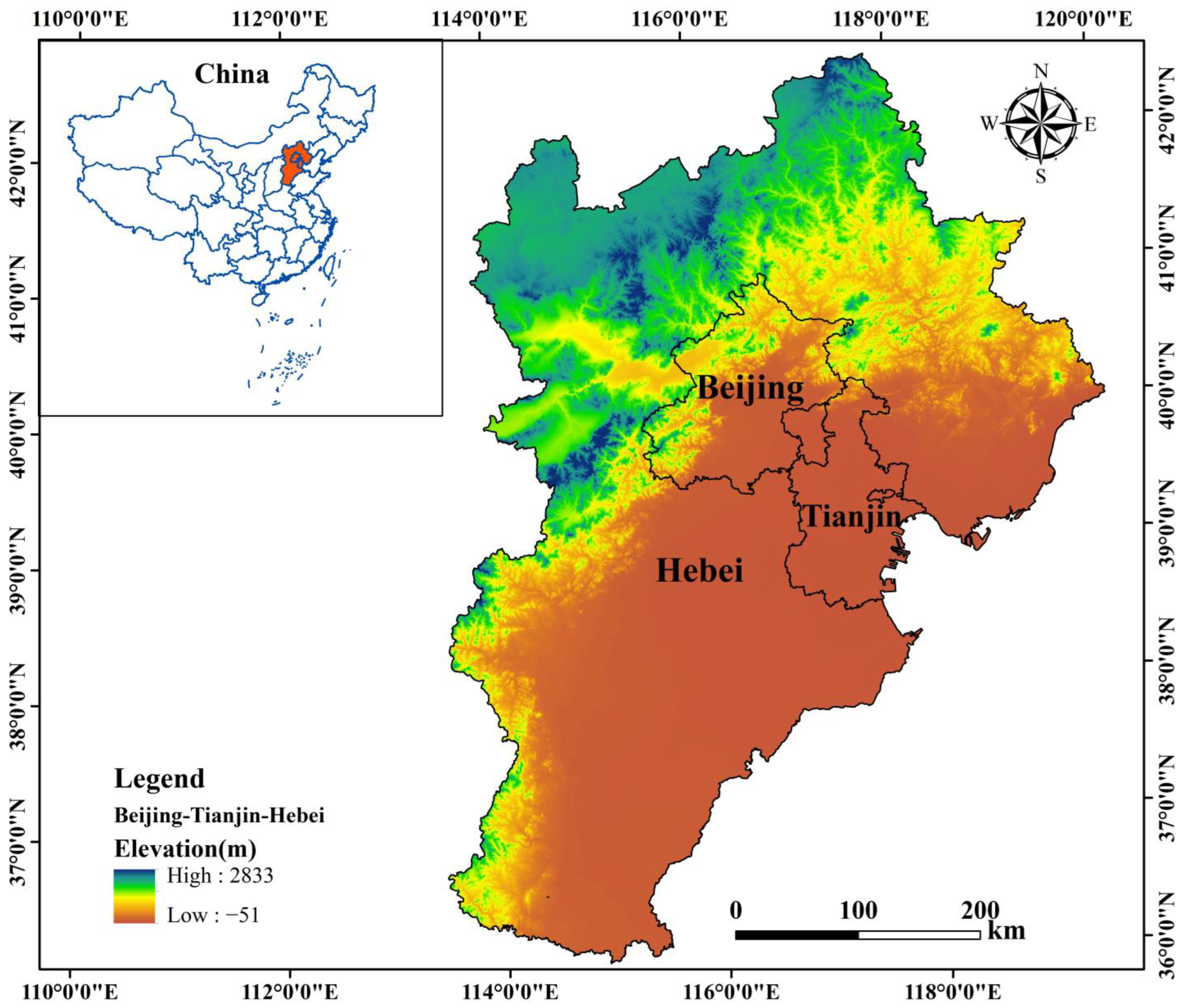
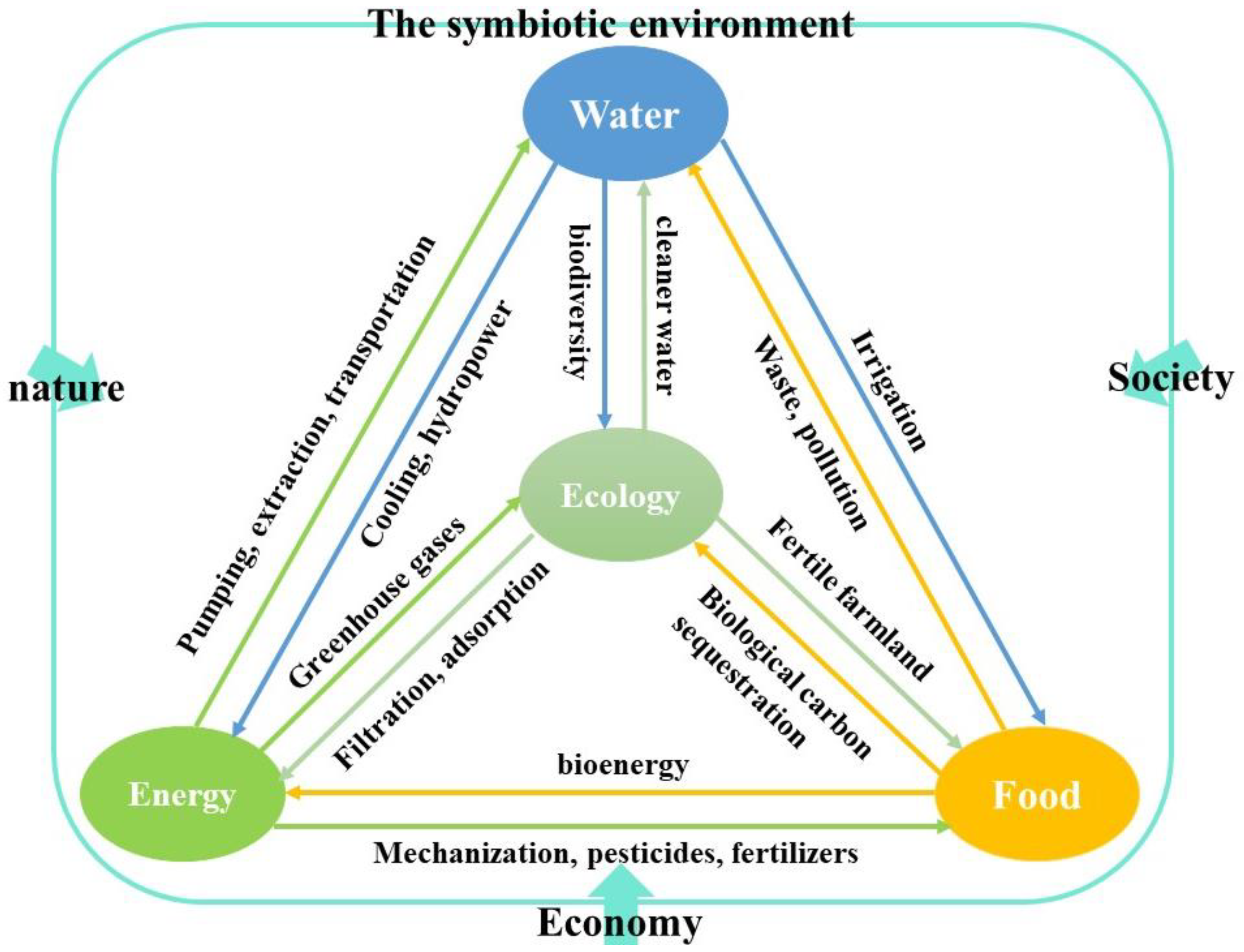
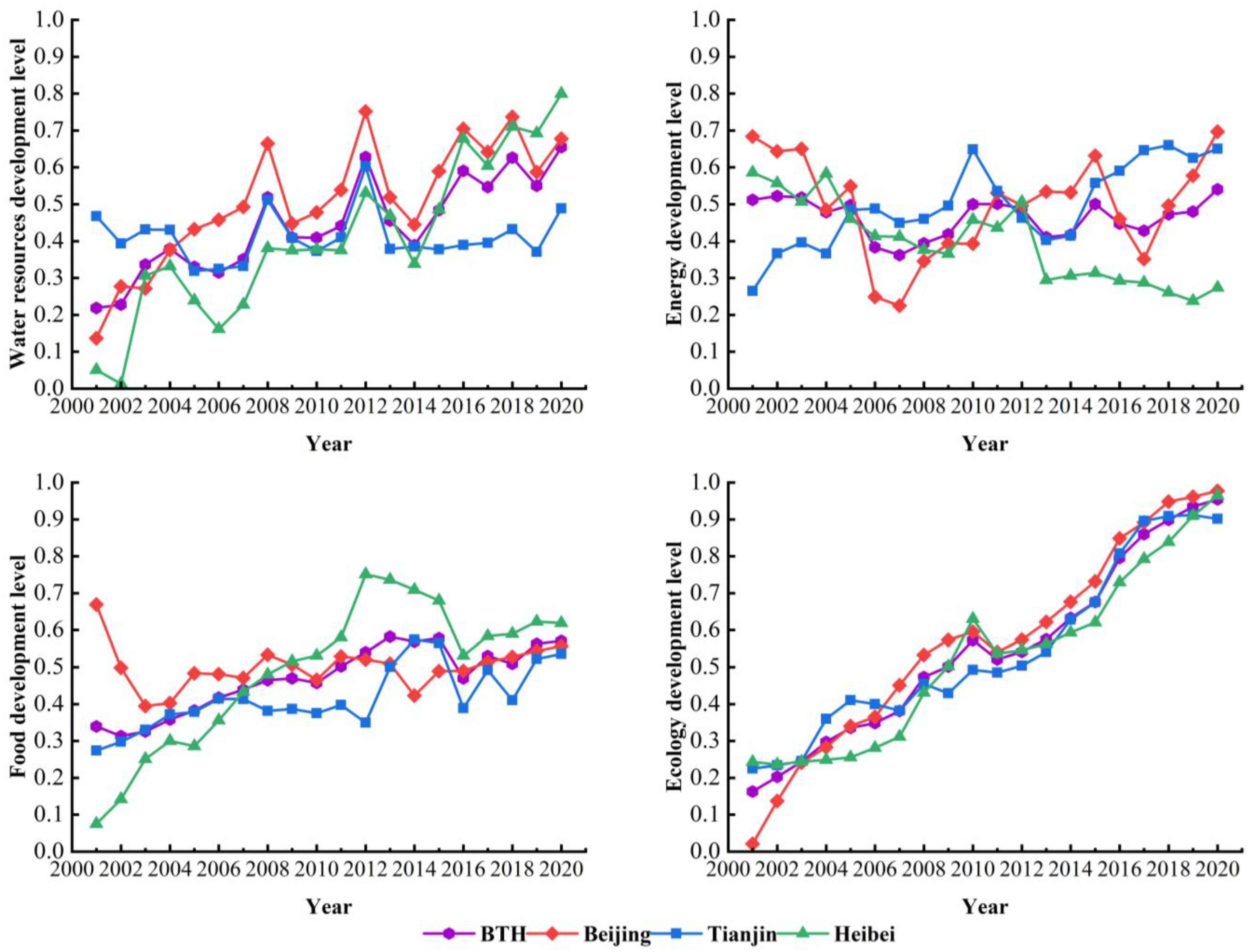
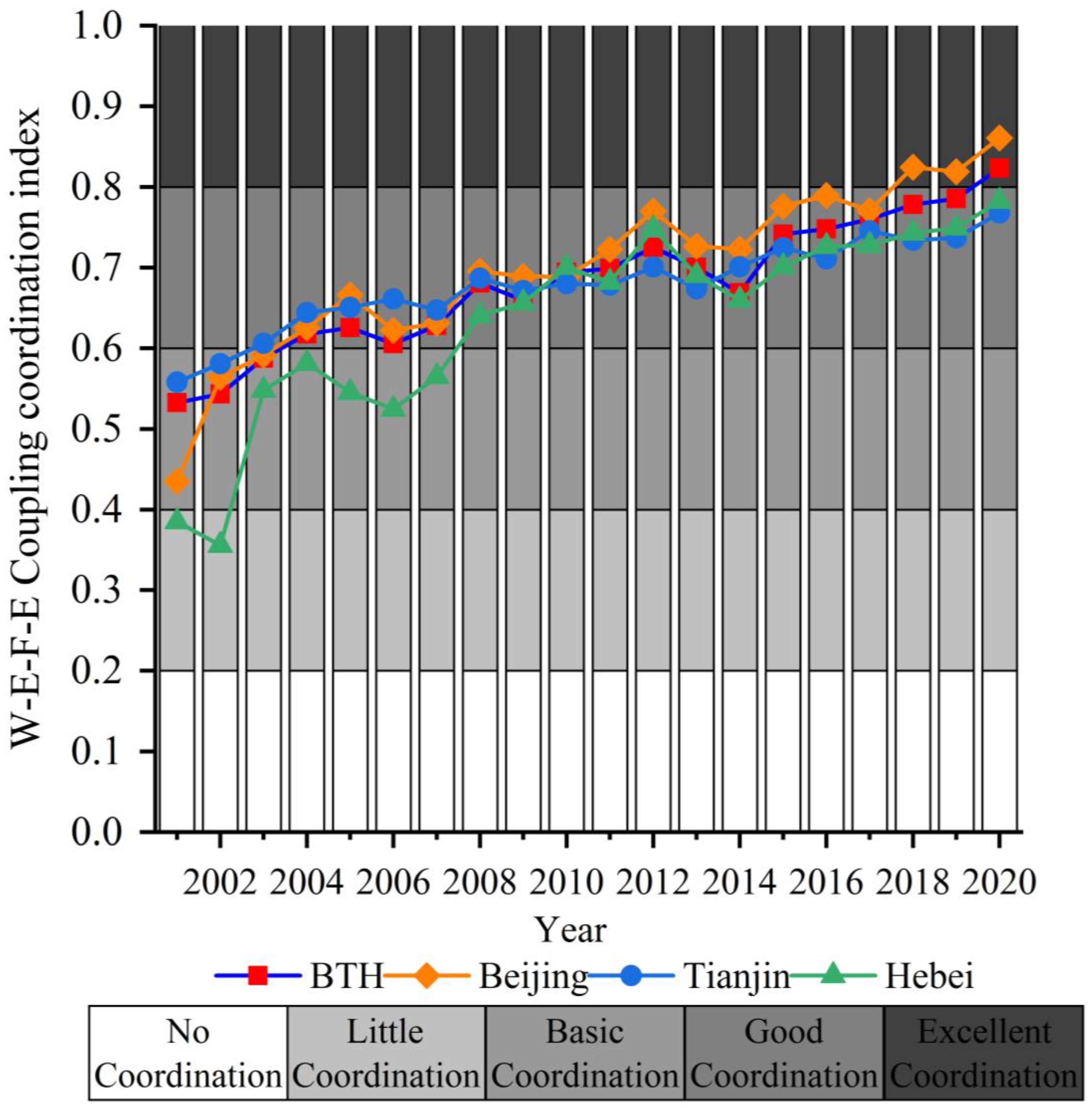
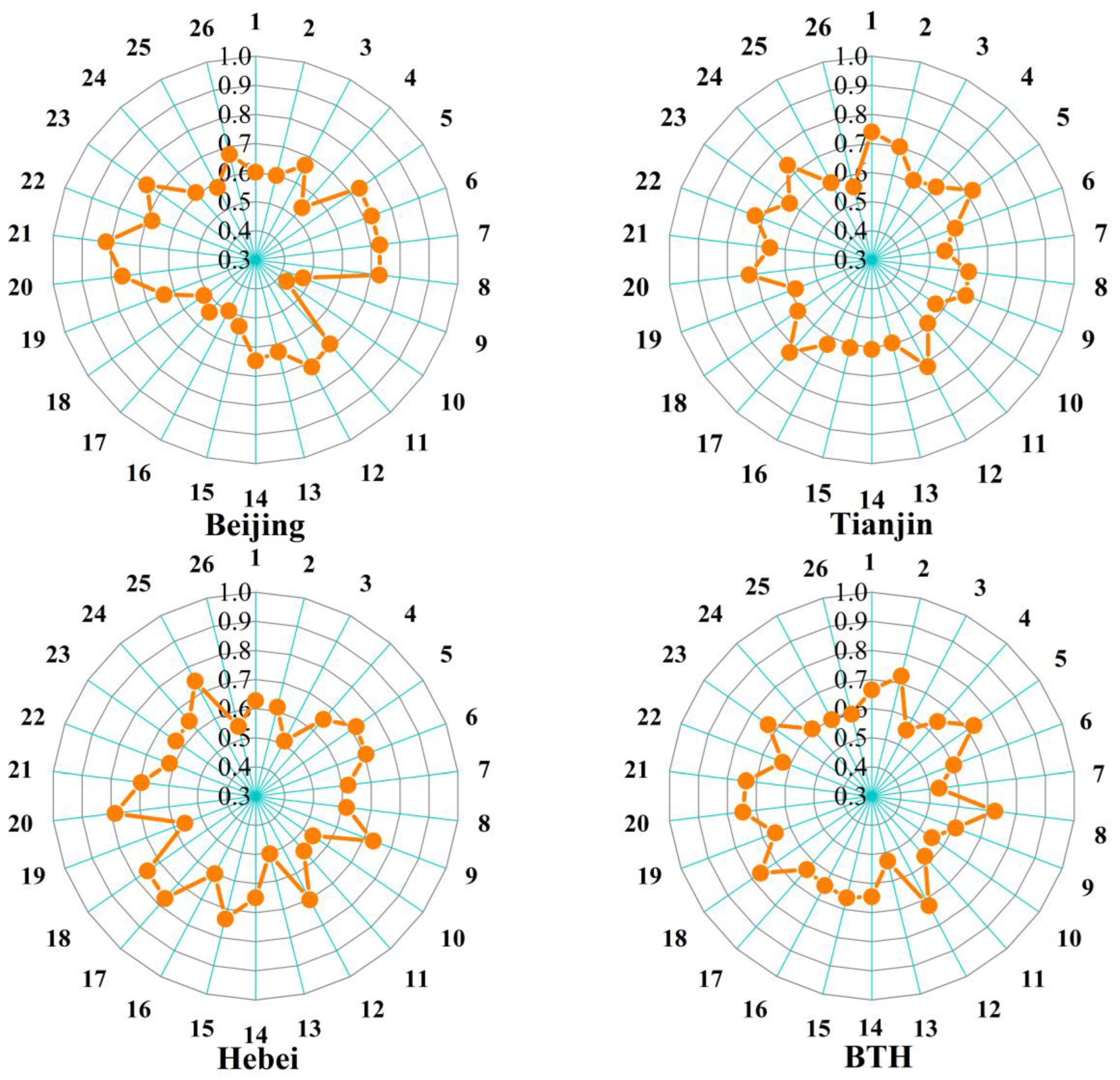
| System Layer | Criterion Layer | Indicator Layer | Unit | Properties |
|---|---|---|---|---|
| Water Resources | Total metrics | C1: Water resources per capita | m3/per | + |
| C2: Total water resources | 109 m3 | + | ||
| C3: Total water supply | 109 m3 | - | ||
| C4: Water consumption | 109 m3 | - | ||
| Consumption indicators | C5: Agricultural water consumption | 109 m3 | - | |
| C6: Industrial water consumption | 109 m3 | - | ||
| C7: Ecological water consumption | 109 m3 | + | ||
| C8: Water consumption of 10,000 Yuan GDP | m3/104 Yuan | - | ||
| Energy | Production index | C9: Total energy production | 10,000 tons | + |
| C10: Energy self-sufficiency rate | % | + | ||
| C11: Energy consumption per capita | tons | - | ||
| Consumption indicators | C12: Energy consumption per unit of GDP | tons/104 Yuan | - | |
| C13: Industrial energy consumption | 10,000 tons | - | ||
| Food | Yield index | C14: Food yield per unit area | tons/hm2 | + |
| C15: Food production per capita | tons | + | ||
| Production conditions | C16: Food cultivation area | 10,000 hm2 | - | |
| C17: Effective irrigated area | 10,000 hm2 | + | ||
| C18: Total power of agricultural machinery | 10,000 kw | + | ||
| C19: Rural electricity consumption per capita | kw/h | - | ||
| Ecology | Ecological quality | C20: Urban greening coverage | % | + |
| C21: Green space per capita | per/m2 | + | ||
| Environmental management | C22: Sewage treatment rate | % | + | |
| C23: Domestic waste disposal rate | % | + | ||
| Emission indicators | C24: Chemical oxygen demand emission | 10,000 tons | - | |
| C25: Fertilizer application amount | 10,000 tons | - | ||
| C26: Sulfur dioxide emissions | 10,000 tons | - |
| Type | Coordination Stage | CCD Value | Development Level |
|---|---|---|---|
| Coordinated | Excellent coordination | 0.90~1.00 | Quality coordinated development |
| 0.80~0.89 | Well-coordinated development | ||
| Good coordination | 0.70~0.79 | Intermediate coordinated development | |
| 0.60~0.69 | Primary coordinated development | ||
| Transition | Basic coordination | 0.50~0.59 | Barely coordinated development |
| 0.40~0.49 | Near dysfunctional recession | ||
| Recession disorders | Little coordination | 0.30~0.39 | Mild dysfunctional recession |
| 0.20~0.29 | Moderate dysfunctional recession | ||
| No coordination | 0.10~0.19 | Severe dysfunctional recession | |
| 0.00~0.09 | Extreme dysfunctional recession |
Disclaimer/Publisher’s Note: The statements, opinions and data contained in all publications are solely those of the individual author(s) and contributor(s) and not of MDPI and/or the editor(s). MDPI and/or the editor(s) disclaim responsibility for any injury to people or property resulting from any ideas, methods, instructions or products referred to in the content. |
© 2023 by the authors. Licensee MDPI, Basel, Switzerland. This article is an open access article distributed under the terms and conditions of the Creative Commons Attribution (CC BY) license (https://creativecommons.org/licenses/by/4.0/).
Share and Cite
Liu, S.; Wang, L.; Lin, J.; Wang, H.; Li, X.; Ao, T. Evaluation of Water-Energy-Food-Ecology System Development in Beijing-Tianjin-Hebei Region from a Symbiotic Perspective and Analysis of Influencing Factors. Sustainability 2023, 15, 5138. https://doi.org/10.3390/su15065138
Liu S, Wang L, Lin J, Wang H, Li X, Ao T. Evaluation of Water-Energy-Food-Ecology System Development in Beijing-Tianjin-Hebei Region from a Symbiotic Perspective and Analysis of Influencing Factors. Sustainability. 2023; 15(6):5138. https://doi.org/10.3390/su15065138
Chicago/Turabian StyleLiu, Shuyuan, Lichuan Wang, Jin Lin, Huan Wang, Xuegang Li, and Tianqi Ao. 2023. "Evaluation of Water-Energy-Food-Ecology System Development in Beijing-Tianjin-Hebei Region from a Symbiotic Perspective and Analysis of Influencing Factors" Sustainability 15, no. 6: 5138. https://doi.org/10.3390/su15065138
APA StyleLiu, S., Wang, L., Lin, J., Wang, H., Li, X., & Ao, T. (2023). Evaluation of Water-Energy-Food-Ecology System Development in Beijing-Tianjin-Hebei Region from a Symbiotic Perspective and Analysis of Influencing Factors. Sustainability, 15(6), 5138. https://doi.org/10.3390/su15065138





